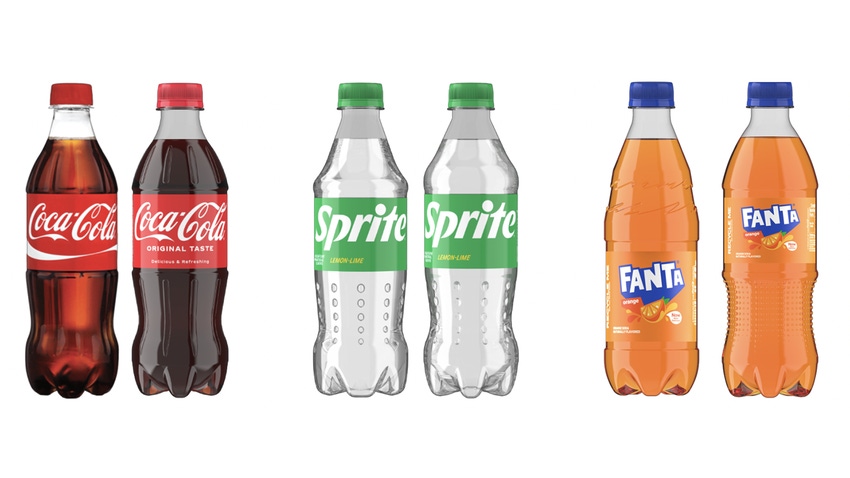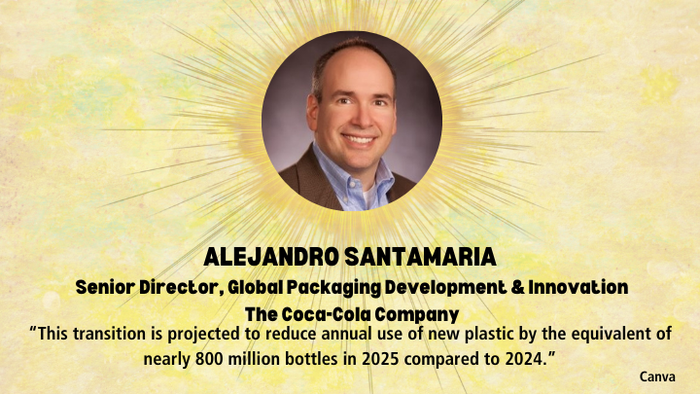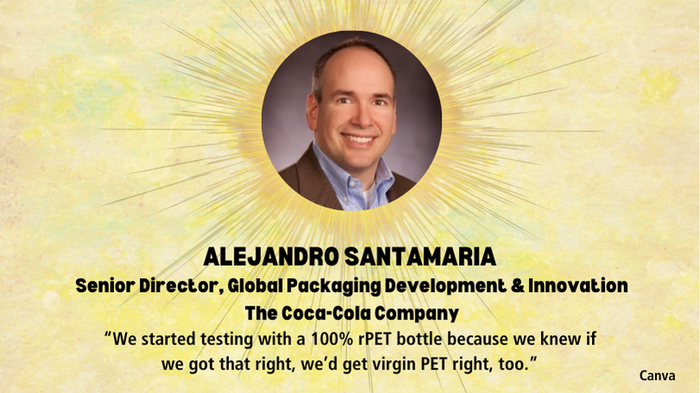How Coca-Cola Bottles Lost Weight
Fifteen questions answered about a complex project involving the brand’s small PET bottles that was three years in development.

At a Glance
- The Coca-Cola Company redesigned and lightweighted its small PET bottles.
- It’s the brand’s first bottle redesign in decades for the US and Canada.
- The company expects to reduce its use of virgin PET by the equivalent of 800 million bottles.
The Coca-Cola Company's first bottle redesign in decades is a key part of the brand's latest lightweighting initiative in the US and Canada. The new shape reduces the weight of each bottle from 21g to 18.5g.
The innovation spans 12-, 16.9-, and 20-oz bottle sizes across the brand’s sparkling, Minute Maid Refreshments, and Minute Maid Aguas Frescas portfolio. Coca-Cola trademark 20-oz 100% recycled rPET plastic bottles (excluding caps and labels) will be available in the new bottle as well.
Through this packaging initiative, the company expects to reduce carbon emissions in 2025 compared to 2024 in an amount equivalent to taking more than 17,000 cars off the road for a year.

Implementation has already begun and will continue throughout 2024.
Alejandro Santamaria, senior director, global packaging development & innovation, The Coca-Cola Company, responds to our questions.
1. What was the specific goal?
Santamaria: We wanted to lightweight our bottles to reduce our use of new plastic and take measurable steps towards our World Without Waste sustainable packaging goals of reducing PET use by 3 million metric tons (3,306,9334 US tons) by 2025. This transition is projected to reduce annual use of new plastic by the equivalent of nearly 800 million bottles in 2025 compared to 2024, so this lightweighting innovation will help the company work toward this goal, while also helping reduce its overall carbon footprint.
2. Why make this change now?
Santamaria: We’ve been continuously working to “right-weight” our bottles incrementally going from 27 to 21 grams over the last 10 years. Between getting partners on board and product R&D, this all takes time, and we wanted to ensure we were doing it correctly.
We’d reached the limit with our previous designs, so it was the right time to refresh the design to open the opportunity for further plastic reduction. The Coca-Cola Company recognizes its responsibility to help solve the global plastic packaging waste problem, and we know that lightweighting is just one step of the process.
3. What was the time frame start to finish?
Santamaria: This project started in April 2021, with implementation beginning in March 2024. This has been a labor of love for quite some time, but we’re lucky to have so many amazing partners who were willing and eager to contribute along the way as they each have their own sustainability goals that help propel us forward collectively.

The brand's carbonated soft drinks portfolio is part of the lightweighting initiative. THE COCA-COLA COMPANY
4. Will consumers notice the difference?
Santamaria: We took the opportunity to refresh and modernize our bottle designs while incorporating new technology to ensure the consumer has the best possible drinking experience. There are minor changes in the bottle shape for Coca-Cola and Sprite Trademark, and all other sparkling brands. Minute Maid Refreshments and Minute Maid Aguas Frescas will have a new, standardized shape with labels moving up on the bottle to match placement of the Coca-Cola and Sprite trademark.
Prior to getting these out in market, there was a lot of data collection and consumer research done behind-the-scenes to ensure consumers felt good about the changes being made to the bottles and the response was positive.
The product remains unchanged, retaining that quality taste consumers expect from The Coca-Cola Company.
5. How many internal groups or team members were involved in the development?
Santamaria: Countless teams played a pivotal role bringing this initiative to life, including cooperatives, bottling network, R&D, quality control, and so many more.
6. How many plants are involved?
Santamaria: The Coca-Cola system consists of 64 independently owned bottlers in the US, for example Coca-Cola Bottling Company United, Reyes Coca-Cola Bottling, Liberty Coca-Cola, Coca-Cola Southwest Beverages, Swire Coca-Cola, and Coca-Cola Consolidated Inc. We have one bottler in Canada, Coke Canada Bottling Limited.
7. Can you credit the vendors or partner companies involved?
Santamaria: Preforms for the North American system are provided by two cooperatives that are part of The Coca-Cola Company network: Southeastern Container Inc. and Western Container Corp.
8. Specifically, how was this achieved?
Santamaria: First, we needed to get bottlers throughout the network excited by the idea. We knew some existing bottle designs were not conducive to lightweighting, so we needed to refresh the design completely to get below the 21g mark. From there, we piloted a research lab to develop and test the bottles. As the project got bigger and we entered the more advanced stages, we brought in a design team, suppliers, and more to bring the initiative to life. In terms of the plastic cuts, we reduced plastic from where it wasn’t needed based on the updated designs.
9. What adjustments were needed to accommodate this change?
Santamaria: Our suppliers’ existing preform equipment was retooled to produce the new 18.5g preform design, then bottlers supported this sustainability progress by investing in capital for new molds. Additionally, there were small adjustments to filling, capping, labeling, and packing equipment to compensate for the small dimensional differences of the new bottle designs.
10. Tell us about the biggest challenge.
Santamaria: The toughest challenge was perfecting the design and structure of the bottles so that the quality of the beverage remained the same. As one of the largest beverage companies in the nation, a 2.5g reduction per bottle is quite significant, so the bottles needed to go through intensive testing and research.
11. Please comment on the rollout timing and locations.
Santamaria: Implementation began in March and our bottlers across the country in the West, Midwest, Southwest and Southeast are already beginning to roll out the new bottles. Throughout the rest of the year, we will continuously roll out the new designs across the rest of the US and Canada, with plants expecting to open in June and October.

12. How do development costs compare to projected return-on-investment?
Santamaria: We anticipate favorable ROI due to cost savings from reduced material usage. This initiative not only aligns with our commitment to a circular economy for our packaging, but also represents a strategic investment expected to yield long-term financial and environmental benefits, enhancing both brand value and standardizing bottle shapes to align with global designs.
13. How did you balance lightweighting without the bottle becoming flimsy?
Santamaria: The secret was finding the right design features that allowed us to lightweight the bottle without compromising the quality of the drink or drinking experience. The new bottles are optimized to reduce weak points in the bottle, preventing carbon dioxide loss and retaining the bubbliness that we all know and love from our favorite drinks. We found the sweet spot of functionality, so the bottle’s shape and feel is still appealing.
14. Did you account for using recycled content (rPET)?
Santamaria: We started testing with the 100% rPET bottle because we knew if we got that right, we’d get virgin PET right, too. Each of the bottles has gone through rigorous testing to ensure they uphold the standard people have come to know and love from The Coca-Cola Company.
We recently announced the launch of our 100% rPET initiative, where all versions of 20-oz Coca-Cola bottles will be made from 100% recycled plastic (excluding cap and label) in the US and Canada. We’re excited to be implementing both lightweighting and 100% rPET to the 20oz Coca-Cola Trademark bottles.
15. Final thoughts?
Santamaria: Making our packaging more sustainable is something we take seriously, and this expansion is a major step forward for us in driving a circular economy for our packaging. The use of 100% rPET, coupled with our lightweighting initiative, is a tangible step towards achieving our World Without Waste strategy.
About the Author(s)
You May Also Like




